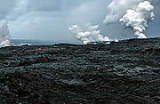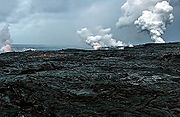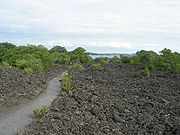
Xerosere
Encyclopedia
Xerosere is a plant succession which is limited by water availability. It includes the different stages in a xerarch succession. Xerarch succession of ecological communities originated in extremely dry situation such as sand desert
s, sand dunes, salt deserts, rock deserts etc. A xerosere may include lithosere
s (on rock) and psammosere
s (on sand).
 Bare rocks are produced when glacier
Bare rocks are produced when glacier
s recede or volcano
es erupt. Erosion of these rocks is brought by rain water and wind loaded with soil particles. The rain water combines with atmospheric carbon dioxide that corrodes the surface of the rocks and produce crevices. Water enters these crevices, freezes and expands to separate boulders. These boulders move down under the influence of gravity and wear particles from the rocks. Also when the wind loaded with soil particles strikes against the rocks, it removes soil particles. All these processes lead to formation of a little soil at the surface of these bare rocks. Animals such as spiders which can hide between boulders or stones invade
these rocks. These animals live by feeding on insects which have been blown in or flown in. Algal
and fungal
spores reach these rocks by air from the surrounding areas. These spores grow and form symbiotic association, the lichen
, which act as pioneer species of bare rocks. The process of succession starts when autotroph
ic organisms start living in the rocks.
lichen
s can adhere to the surface of rock and absorb moisture from atmosphere; therefore, these colonize the bare surfaces of rocks first. The propagules of these lichens are brought by air from the surrounding areas. These lichens produce acids which corrode the rock and their thalli collect wind blown soil particles among them that help in formation of a thin film of soil. When these lichens die their thalli are decomposed to add humus. This promotes soil building and the environment becomes suitable for growth of foliose and fruticose type of lichens.
s of xerophytic mosses, such as Polytrichum
, Tortula, and Grimmia
, are brought to the rock where they succeed lichens. Their rhizoid
s penetrate soil among the crevices, secrete acids and corrode the rocks. The bodies of mosses are rich in organic and inorganic compounds. When these die they add these compounds to the soil, increasing the fertility of the soil. As mosses develop in patches they catch soil particles from the air and help increase the amount of substratum. The changing environment leads to migration of lichens and helps invasion of herbaceous vegetation that can out-compete mosses.

Herbaceous weeds, mostly annuals such as asters, evening primrose
s, and milk weeds, invade the rock. Their roots penetrate deep down, secrete acids and enhance the process of weathering. Leaf litter and death of herbs add humus to the soil. Shading of soil results in decrease in evaporation
and there is a slight increase in temperature. As a result the xeric conditions begin to change and biennial
and perennial
herbs and xeric grasses such as Aristida, Festuca, and Poa
, begin to inhabit. These climatic conditions favor growth of bacterial and fungal populations, resulting in increase in decomposition activity.
s establish themselves. The trees form canopy and shade the area. Shade-loving scrubs continue to grow as secondary vegetation. Leaf litter and decaying roots weather the soil further and add humus to it making the habitat more favorable for growth to trees. Mosses and ferns make their appearance and fungi population grows abundantly.
Oak-Hickory Climax Forest: In dry habitat oaks and hickories are climax vegetation. There is only one tree stage and forests are characterized by presence of scrubs, herbs, ferns, and mosses.
Beech-Hemlock Climax Forest: These climax forests develop in mesic climates. The dominant vegetation is Beech and Hemlock. There are many intermediate tree stages. The other vegetation types include herbs, ferns, and mosses.
American Beech-Sugar Maple Climax Forest
: These climax forests develop in mesic climates in the Northeastern United States. The dominant vegetation is American Beech
and Sugar Maple
.
Spruce-Alpine Fir Climax Forest: At high altitudes in Rocky Mountains
the climax forest is dominated by spruce
s and alpine fir
s.
Desert
A desert is a landscape or region that receives an extremely low amount of precipitation, less than enough to support growth of most plants. Most deserts have an average annual precipitation of less than...
s, sand dunes, salt deserts, rock deserts etc. A xerosere may include lithosere
Lithosere
A lithosere is a plant succession that begins life on a newly exposed rock surface, such as one left bare as a result of glacial retreat, tectonic uplift as in the formation of a raised beach, or volcanic eruptions...
s (on rock) and psammosere
Psammosere
A psammosere is a seral community, an ecological succession that began life on newly exposed coastal sand. Most common psammoseres are sand dune systems....
s (on sand).
Bare rocks

Glacier
A glacier is a large persistent body of ice that forms where the accumulation of snow exceeds its ablation over many years, often centuries. At least 0.1 km² in area and 50 m thick, but often much larger, a glacier slowly deforms and flows due to stresses induced by its weight...
s recede or volcano
Volcano
2. Bedrock3. Conduit 4. Base5. Sill6. Dike7. Layers of ash emitted by the volcano8. Flank| 9. Layers of lava emitted by the volcano10. Throat11. Parasitic cone12. Lava flow13. Vent14. Crater15...
es erupt. Erosion of these rocks is brought by rain water and wind loaded with soil particles. The rain water combines with atmospheric carbon dioxide that corrodes the surface of the rocks and produce crevices. Water enters these crevices, freezes and expands to separate boulders. These boulders move down under the influence of gravity and wear particles from the rocks. Also when the wind loaded with soil particles strikes against the rocks, it removes soil particles. All these processes lead to formation of a little soil at the surface of these bare rocks. Animals such as spiders which can hide between boulders or stones invade
Invasive species
"Invasive species", or invasive exotics, is a nomenclature term and categorization phrase used for flora and fauna, and for specific restoration-preservation processes in native habitats, with several definitions....
these rocks. These animals live by feeding on insects which have been blown in or flown in. Algal
Algae
Algae are a large and diverse group of simple, typically autotrophic organisms, ranging from unicellular to multicellular forms, such as the giant kelps that grow to 65 meters in length. They are photosynthetic like plants, and "simple" because their tissues are not organized into the many...
and fungal
Fungus
A fungus is a member of a large group of eukaryotic organisms that includes microorganisms such as yeasts and molds , as well as the more familiar mushrooms. These organisms are classified as a kingdom, Fungi, which is separate from plants, animals, and bacteria...
spores reach these rocks by air from the surrounding areas. These spores grow and form symbiotic association, the lichen
Lichen
Lichens are composite organisms consisting of a symbiotic organism composed of a fungus with a photosynthetic partner , usually either a green alga or cyanobacterium...
, which act as pioneer species of bare rocks. The process of succession starts when autotroph
Autotroph
An autotroph, or producer, is an organism that produces complex organic compounds from simple inorganic molecules using energy from light or inorganic chemical reactions . They are the producers in a food chain, such as plants on land or algae in water...
ic organisms start living in the rocks.
Crustose lichen stage
A bare rock consists of solid surface or very large boulders and there is no place for rooting plants to colonize. The thalli of crustoseCrustose
Crustose is a habit of some types of algae in which the plant grows tightly appressed to a substrate forming a biological layer of the adhering organism...
lichen
Lichen
Lichens are composite organisms consisting of a symbiotic organism composed of a fungus with a photosynthetic partner , usually either a green alga or cyanobacterium...
s can adhere to the surface of rock and absorb moisture from atmosphere; therefore, these colonize the bare surfaces of rocks first. The propagules of these lichens are brought by air from the surrounding areas. These lichens produce acids which corrode the rock and their thalli collect wind blown soil particles among them that help in formation of a thin film of soil. When these lichens die their thalli are decomposed to add humus. This promotes soil building and the environment becomes suitable for growth of foliose and fruticose type of lichens.
Foliose and fruticose lichen stage
Foliose lichens have leaf-like thalli, while the fruticose lichens are like small bushes. They are attached to the substratum at one point only, therefore, do not cover the soil completely. They can absorb and retain more water and are able to accumulate more dust particles. Their dead remains are decomposed to humus which mixes with soil particles and help building substratum and improving soil moisture contents further. The shallow depressions in the rocks and crevices become filled with sold and topsoil layer increases further. These autogenic changes favor growth and establishment of mosses.Moss stage
The sporeSpore
In biology, a spore is a reproductive structure that is adapted for dispersal and surviving for extended periods of time in unfavorable conditions. Spores form part of the life cycles of many bacteria, plants, algae, fungi and some protozoa. According to scientist Dr...
s of xerophytic mosses, such as Polytrichum
Polytrichum
Polytrichum is a genus of mosses — commonly called haircap moss or hair moss — which contains approximately 70 species that cover a cosmopolitan distribution....
, Tortula, and Grimmia
Grimmia
Grimmia is a genus of mosses , originally named by Jakob Friedrich Ehrhart in honour of Johann Friedrich Carl Grimm, a physician and botanist from Gotha, Germany.- Geographic distribution :...
, are brought to the rock where they succeed lichens. Their rhizoid
Rhizoid
Rhizoids are thread-like growths from the base or bottom of a plant, found mainly in lower groups such as algae, fungi, bryophytes and pteridophytes, that function like roots of higher plants ....
s penetrate soil among the crevices, secrete acids and corrode the rocks. The bodies of mosses are rich in organic and inorganic compounds. When these die they add these compounds to the soil, increasing the fertility of the soil. As mosses develop in patches they catch soil particles from the air and help increase the amount of substratum. The changing environment leads to migration of lichens and helps invasion of herbaceous vegetation that can out-compete mosses.
Herb stage

Herbaceous weeds, mostly annuals such as asters, evening primrose
Oenothera
Oenothera is a Genus of about 125 species of annual, biennial and perennial herbaceous flowering plants, native to North and South America. It is the type genus of the family Onagraceae, the Evening Primrose Family. Common names include evening-primrose, suncups, and sundrops.The species vary in...
s, and milk weeds, invade the rock. Their roots penetrate deep down, secrete acids and enhance the process of weathering. Leaf litter and death of herbs add humus to the soil. Shading of soil results in decrease in evaporation
Evaporation
Evaporation is a type of vaporization of a liquid that occurs only on the surface of a liquid. The other type of vaporization is boiling, which, instead, occurs on the entire mass of the liquid....
and there is a slight increase in temperature. As a result the xeric conditions begin to change and biennial
Biennial plant
A biennial plant is a flowering plant that takes two years to complete its biological lifecycle. In the first year the plant grows leaves, stems, and roots , then it enters a period of dormancy over the colder months. Usually the stem remains very short and the leaves are low to the ground, forming...
and perennial
Perennial plant
A perennial plant or simply perennial is a plant that lives for more than two years. The term is often used to differentiate a plant from shorter lived annuals and biennials. The term is sometimes misused by commercial gardeners or horticulturalists to describe only herbaceous perennials...
herbs and xeric grasses such as Aristida, Festuca, and Poa
Poa
Poa is a genus of about 500 species of grasses, native to the temperate regions of both hemispheres. Common names include meadow-grass , bluegrass , tussock , and speargrass. "Poa" is Greek for fodder...
, begin to inhabit. These climatic conditions favor growth of bacterial and fungal populations, resulting in increase in decomposition activity.
Shrub stage
The herb and grass mixture is invaded by shrub species, such as Rhus and Phytocarpus. Early invasion of shrub is slow, but once a few bushes have become established, birds invade the area and help disperse scrub seeds. This results in dense scrub growth shading the soil and making conditions unfavorable for the growth of herbs, which then begin to migrate. The soil formation continues and its moisture content increases.Tree stage
Change in environment favors colonization of tree species. The tree saplings begin to grow among the scrubs and establish themselves. The kind of tree species inhabiting the area depends upon the nature of the soil. In poorly drained soils oakOak
An oak is a tree or shrub in the genus Quercus , of which about 600 species exist. "Oak" may also appear in the names of species in related genera, notably Lithocarpus...
s establish themselves. The trees form canopy and shade the area. Shade-loving scrubs continue to grow as secondary vegetation. Leaf litter and decaying roots weather the soil further and add humus to it making the habitat more favorable for growth to trees. Mosses and ferns make their appearance and fungi population grows abundantly.
Climax stage
The succession culminates in a climax community, the forest. Many intermediate tree stages develop prior to establishment of a climax community. The forest type depends upon climatic conditions. The climax forest may be:Oak-Hickory Climax Forest: In dry habitat oaks and hickories are climax vegetation. There is only one tree stage and forests are characterized by presence of scrubs, herbs, ferns, and mosses.
Beech-Hemlock Climax Forest: These climax forests develop in mesic climates. The dominant vegetation is Beech and Hemlock. There are many intermediate tree stages. The other vegetation types include herbs, ferns, and mosses.
American Beech-Sugar Maple Climax Forest
Beech-maple forest
A beech-maple forest is a climax mesic closed canopy hardwood forest. It is primarily composed of American Beech and Sugar Maple trees which co-dominate the forest and which are the pinnacle of plant succession in their range...
: These climax forests develop in mesic climates in the Northeastern United States. The dominant vegetation is American Beech
American Beech
Fagus grandifolia, also known as American Beech or North american beech, is a species of beech native to eastern North America, from Nova Scotia west to southern Ontario in southeastern Canada, west to Wisconsin and south to eastern Texas and northern Florida in the United States. Trees in the...
and Sugar Maple
Sugar Maple
Acer saccharum is a species of maple native to the hardwood forests of northeastern North America, from Nova Scotia west to southern Ontario, and south to Georgia and Texas...
.
Spruce-Alpine Fir Climax Forest: At high altitudes in Rocky Mountains
Rocky Mountains
The Rocky Mountains are a major mountain range in western North America. The Rocky Mountains stretch more than from the northernmost part of British Columbia, in western Canada, to New Mexico, in the southwestern United States...
the climax forest is dominated by spruce
Spruce
A spruce is a tree of the genus Picea , a genus of about 35 species of coniferous evergreen trees in the Family Pinaceae, found in the northern temperate and boreal regions of the earth. Spruces are large trees, from tall when mature, and can be distinguished by their whorled branches and conical...
s and alpine fir
Fir
Firs are a genus of 48–55 species of evergreen conifers in the family Pinaceae. They are found through much of North and Central America, Europe, Asia, and North Africa, occurring in mountains over most of the range...
s.

